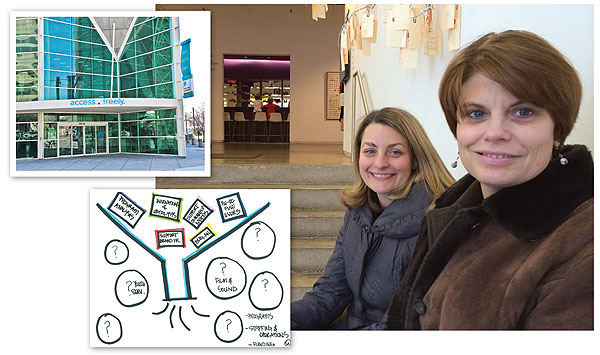Starting from Scratch | Design4Impact
Richland Library, COLUMBIA, SC, (LJ's 2001 Library of the Year) has been making steady, thoughtful progress toward transforming its library space for some time, even though the building is not yet designed. What it’s redesigning first is the design process itself. The goal: to activate the library anew.
As early as 2010, Richland executive director Melanie Huggins was planning to renovate the 200,000 square foot main library. She presented it as a challenge at LJ’s Design Institute in Greenville, SC, led by architect David Moore, then with Craig Gaulden Davis and now with McMillan Pazdan Smith Architecture. The focus was on economical, concrete solutions.
Since then, the project has expanded. Moore is still an integral part, now also working in tandem with designer Margaret Sullivan. In 2013, the county passed a $59 million referendum to “enhance and redefine” ten of its 11 branches. (The last is already state-of-the-art.) Richland plans to transform the Central Library, then roll the resulting concept out to the branches, including two new ones yet to be built. Each will host a series of community focus groups so customers can help craft plans.

Margaret Sullivan (l.) and Roberta Bibbins visit New York City’s Children’s Museum of the Arts, mining nontraditional sites for ideas for Richland Library (inset, top) and a new design framework (inset, bottom). Large photo by Rebecca T. Miller
Shaping studios
Key to Richland’s vision is to turn the library into a “studio,” where the community is engaged in making as well as consuming, exploring ideas, practicing talents, taking risks, uncovering passions, and being innovative. This is much broader than the usual Maker space and includes five studio concepts: teen, career, arts and literature, media and technology, and education.
To help them think outside the library, Huggins, Sullivan, project coordinator (and 2013 LJ Mover & Shaker) Roberta Bibbins, and others came to New York City this February for a whirlwind tour of locations that exemplify these traits. Sites seen included BRIC House, a multidisciplinary arts and media center; NeueHouse, a coworking performance and event venue; Powerhouse Arena, a combination gallery, boutique, bookstore, and performance and events space; and the Children’s Museum of the Arts.
Huggins told LJ that one of her top takeaways from the trip is that “spaces for creating content [should] also include spaces for presenting content.”
This and other lessons will be folded into a framework for thinking about library space that is “about building spaces for people and not building spaces for things,” Bibbins said, in what could serve as an informal mantra for the process.
For each kind of studio, the Richland team asks themselves what are the outcomes, who is the audience, what kinds of activities happen here, what should it look and feel like, what are the self-directed activities, what are the assisted activities, and how would an individual spend an hour or a day here.
Each studio will be designed to engage with many different learning styles and to offer opportunities for socializing, for solitude, and for interactions with the collection and technology. The team even plans to apply the studio concept to staff workspaces.
Designing a new model
As catalysts for developing a nontraditional model, the library started with keywords: innovation, customization, adaptability, creativity, and interactivity. After considering conventional library spaces, users, and furnishings, the members evaluated each space and activity against how it met their goals and their communities’ and examined the needs of different populations to create new user profiles and a new service model, which in turn will drive space design.
The key, said Huggins, is to make sure that each choice is tied back to the library mission.
“It’s about creating the conditions that promote the activities that are timeless, even though the tools are not,” explained Sullivan. While libraries were once designed to last for 20 years, to accommodate those perpetually evolving tools, Sullivan’s goal for Richland is subtly yet crucially different. The goal, she says, is a building that “will grow for 20 years.”
ALREADY A SUBSCRIBER? LOG IN
We are currently offering this content for free. Sign up now to activate your personal profile, where you can save articles for future viewing









Add Comment :-
Comment Policy:
Comment should not be empty !!!